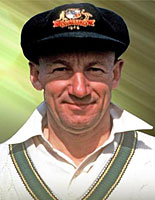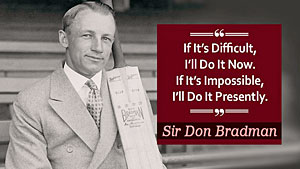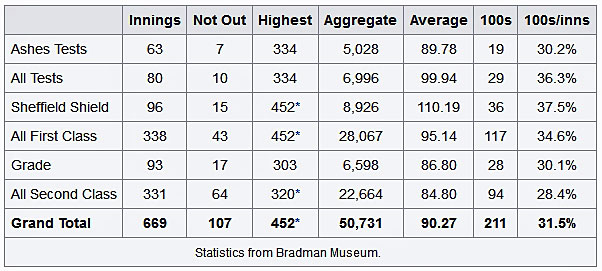

| Don's family details are available in my family files. |

Sir Donald George Bradman (born 1908) was an Australian cricketer — acclaimed as the greatest batsman, if not cricketer, of all time. He was born in Cootamundra, New South Wales, on August 27, 1908, the youngest child of a farmer/carpenter. The family lived in Yeo Yeo and moved to Bowral in 1911 because of his mother's health. He learned his cricket from his maternal uncles George and Richard Whatman. His mother used to bowl left-armers to him in the backyard. Bradman developed his batting by throwing a golf ball against a tank stand and playing it with a stump, and his fielding by throwing a golf ball at the bottom rail of a fence.
As a teenager Bradman played Saturday afternoon cricket in the country and quickly proceeded to amass huge scores. In 1926 the New South Wales Cricket Association, which was incidentally looking for bowlers, asked Bradman to play in trial games. While making modest scores, he nonetheless attracted the eye of the selectors as a player of the future. He played grade cricket with the St. George club in Sydney (he later played with North Sydney and, after moving to Adelaide, South Australia in 1935, with the Kensington club). After some impressive scores he played in his initial first class game for New South Wales against South Australia in 1927 and scored a century. After a series of big scores at the beginning of the 1928-1929 season, he was chosen to play for Australia against Perry Chapman's English side. While performing poorly in the first test and being dropped to 12th man for the second, he scored two centuries in the remaining rubbers to establish his place in the Australian team.

Being a self-taught batsman, much criticism was directed at Bradman's lack of style, his tendency to play cross bat shots, and the problems he would encounter on softer English wickets. Bradman answered his critics by consistently amassing huge scores. Throughout his career he was a fast and high scoring batsman who could reduce even the best bowling attacks to seeming mediocrity. His initial tour of England in 1930 can only be described as a triumphal procession in which he established himself as a figure of international stature. He scored 2, 960 runs on tour at an average of 98.66. In test matches he scored 974 runs at an average of 139.14, including scores of 131, 254, 334, and 452. On both the 1930 and 1938 tours of England he scored 1, 000 runs before the end of May. He became the only player to achieve such a distinction. In the 1938-1939 season he scored six centuries in a row, equaling C. B. Fry's record. Only the bodyline bowling, where the ball is pitched short and aimed in the general direction of the head, employed by Douglas Jardine's 1932-1933 English side curbed Bradman. His average fell to 56.57, which would still be the envy of most batsmen. Such was the hostility generated by bodyline bowling (which was eventually outlawed) that diplomatic exchanges occurred between Australia and England.
Bradman's average in first class cricket was 95.14, and in test cricket it was 99.94, being only four runs short of a 100 average. He scored 117 centuries in first class cricket (29 in tests), a century every third time he batted. His centuries included 31 double (ten in tests), five triple (two in tests), and one quadruple century—his famous 452 got out against Queensland in 1930.

In 1936 Bradman was appointed captain of Australia to oppose Gubby Allen's touring English side. He continued captaining Australia until 1948, notwithstanding a five year absence from cricket caused by World War II. Bradman was a most successful captain. In the 24 tests while he was captain Australia won 15, lost three, and drew six. The team which toured England in 1948 had the distinction of never losing a game.
The late 1980s and 1990s saw a spate of biographical material on Bradman. In 1988 he released his book, The Bradman Albums, and two biographies of him, Charles Williams' Bradman: An Australian Hero, and Roland Perry's book, The Don, were published in 1996. Clearly time does not diminish Bradman's status as a hero in his native Australia, or anywhere else that appreciates cricket.
.jpg) Bradman Museum and International Cricket Hall of Fame
The Bradman Foundation, a non-profit charitable trust, was established in 1987 with the full support of Sir Donald Bradman AC to promote cricket as a valuable cultural and sporting force within the community, and established a Museum adjacent to the local cricket oval, named the Bradman Oval. In 2010 the Bradman Foundation opened the International Cricket Hall, located inside the Bradman Museum at Bowral, New South Wales. This remit has now been expanded to reflect the place and contribution of the game of cricket in world history. The new visitor experience was made possible in 2008 by the Federal Government, to officially acknowledge the centenary of Sir Donald Bradman’s birth. It is well worth a visit.
Bradman Museum and International Cricket Hall of Fame
The Bradman Foundation, a non-profit charitable trust, was established in 1987 with the full support of Sir Donald Bradman AC to promote cricket as a valuable cultural and sporting force within the community, and established a Museum adjacent to the local cricket oval, named the Bradman Oval. In 2010 the Bradman Foundation opened the International Cricket Hall, located inside the Bradman Museum at Bowral, New South Wales. This remit has now been expanded to reflect the place and contribution of the game of cricket in world history. The new visitor experience was made possible in 2008 by the Federal Government, to officially acknowledge the centenary of Sir Donald Bradman’s birth. It is well worth a visit.